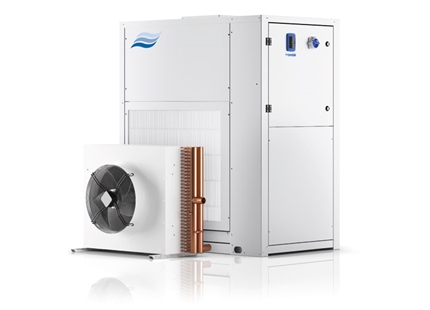Humidity control & dehumidification for water treatment plants
The very nature and location of water treatment plants means that ambient humidity levels will typically be high. This together with the fact that temperature may not always be that precisely controlled can lead to condensation, resulting in considerable damage and shorter operational component lifespan. Air with an ambient humidity of 75%RH only needs to cool by about 5°C to reach dew point (the temperature at which liquid condensation forms).
Water temperature inside pipes is often much lower than air dew points, particularly in summer or in heated facilities. This results in condensation forming on the outside of cool pipes, valves and controls in the water treatment plant. This liquid condensation will corrode metal surfaces. On electrical components, such as pumps, motors and switch gear, damage to components and electrical circuits can significantly interfere with the operation of the facility.
Reducing the air humidity in the plant with a commercial dehumidification system lowers the risk of corrosion, as the temperature needed for condensation to form becomes lower as the air becomes drier.
-
Pipes with cold water in will become cold, which in turn chills the air touching the pipe. As the air cools, it's relative humidity increases. If the air's relative humidity reaches 100%, the water can no longer remain in a gasous state and it becomes liquid water, resulting in condensation on the cold surface of the pipe.
-
Depending on the temperature difference between the ambient air and the pipe's surface temperature, it is possible to prevent condensation with insulation. Insulation will prevent the air from touching the cold surface of the pipe. However, it may require 50 to 100mm of insulation to acheive this. Additionally there must be no “cold bridges”, where a thermally conductive material is in contact with both the pipe and the ambient air.
Reducing the ambient humidity so the dew point or the air is below the temperature of the pipe offers a better solution. -
The best type of dehumidifier for any specific application will depend on the environment it's being used in and the level of control needed. Very cold or close control drying applications will benefit from using desiccant dehumidifiers. Dehumidification at conditions above 15-20°C and for humidity control of 50%RH and above would largely benefit from condensing dehumidifier technology.
-
To prevent condensation on pipes, the air dew point temperature has to be below the pipe surface temperature to prevent moisture condensing on the cold surface. To calculate what relative humidity the air would need to be for the air dew point temperature not to be reached, you would need to know the surface temperature of the pipe and the ensure that the absolute moisture content in the air surrounding the pipe is less than the surface temperature at 100%RH.
-
It is very dependent on the principle of operation but as a guide a condensing dehumidifier will use approximately 0.4kW/litre of water removed, compared to approximately 1.4kW/litre for a desiccant unit. The higher power consumption of a desiccant is from the regeneration heaters used to remove the water from the desiccant material.
Get free expert advice on dehumidification in water treatment plants

PODCAST: HOW TO SIZE & SELECT A DEHUMLearn the important things to consider when approaching a commercial dehumidifier project.

Free 10-point guide to specifying dehumidifiers
Download your free 10-point guide to specifying dehumidifiers and get an easy-to-follow overview for planning dehumidifier projects.
It covers system design, dehumidifier selection & sizing, drying psychrometrics, energy saving and much more.
You may also be interested in...

Condair DC-LT low temperature condensing dehumidifier

Condair DC-N dehumidifier with external condenser

Condair DC wall and ceiling mounted condensing dehumidifiers

Condair DP swimming pool dehumidifiers

Condair DC condensing dehumidifiers
